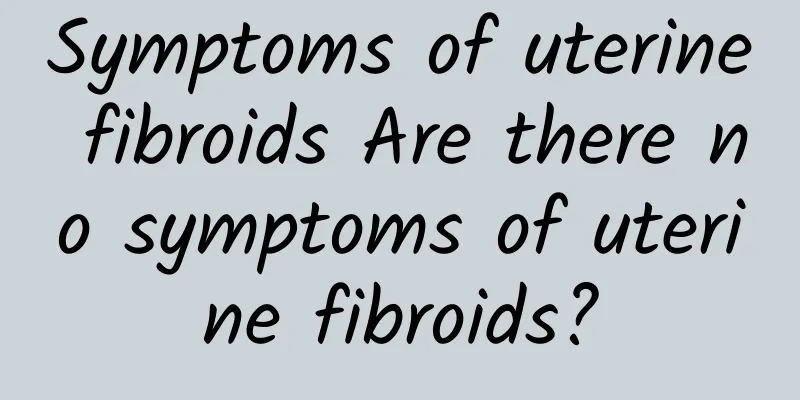Symptoms of uterine fibroids Are there no symptoms of uterine fibroids?

|
As the saying goes, location is important. It doesn't matter whether a person can do it or not, as long as it is placed in a key position, it will be very important. This is very suitable for explaining the symptoms of uterine fibroids, because whether uterine fibroids have symptoms and the severity of the symptoms are related to the growth site and size, especially the growth site. Uterine fibroids are located under the serosa on the outer surface of the uterus, and the abdominal cavity has a lot of room for development. Even if the tumor grows very large, sometimes there are no symptoms; uterine fibroids are located on the inner surface of the uterus, because it affects the function of the endometrium, even if it is very small, irregular vaginal bleeding will occur. Generally speaking, uterine fibroids can cause the following common symptoms, but for every patient, it is impossible to have all the symptoms, but only one or more of them. 1) Vaginal bleeding: It should be the most common symptom of uterine fibroids. Uterine fibroids are located on the outer surface of the uterus, and there is usually no vaginal bleeding. When the intramural fibroids are larger, they will affect uterine contraction, or increase the area of the endometrium, causing menorrhagia or prolonged menstruation. Submucosal fibroids in the uterus often cause irregular vaginal bleeding, bleeding menstruation, etc. Of course, there are many reasons for vaginal bleeding. It should be reminded that if this symptom occurs, do not think that it is too tired or menopausal in the near future. 2) Pelvic mass: Most of the time it is found by accident (such as bathing or sexual intercourse) or during gynecological examination. When the fibroids are too large or the patient is too thin, you can feel a hard solid mass in the lower abdomen, especially in the morning before urination, the bladder is easier to feel. Sometimes you may not be able to touch the tumor, but you will find that the waist circumference has increased, and some middle-aged and elderly people will naturally think it is fat. In remote rural areas with poor medical conditions, or some people in cities, fibroids can grow to a large size. For women of childbearing age, if a pelvic mass is found, the most important thing to consider is not uterine fibroids, but pregnancy, which is emphasized in textbooks. 3) Compression symptoms: Uterine fibroids can compress adjacent organs and cause symptoms. Again, symptoms vary depending on location (growth site) and size. Fibroids compress the bladder forward, causing frequent urination, urgency, or even inability to urinate (called urinary retention); if the fibroids grow on the posterior wall of the uterus, they can compress the rectum backwards and cause diarrhea or constipation; fibroids in the broad ligaments on both sides of the uterus can compress the ureters, internal and external iliac veins, and nerves, causing ureteral obstruction, hydronephrosis, lower extremity edema, or pain. 4) Infertility: Small fibroids or subserous fibroids located in the uterine wall usually do not affect pregnancy. However, some fibroids may change the shape of the uterine cavity, or hinder the implantation of the fertilized egg, or grow in the corners of the uterus, compressing the opening of the fallopian tube into the uterus, hindering the rising sperm from entering the fallopian tube, and causing infertility. 5) Abdominal pain: Uterine fibroids rarely cause abdominal pain. If the fibroids excessively compress the pelvic nerves, or if acute ischemia causes red degeneration, or if a pedunculated subserosal uterine fibroid torsions, it can cause severe abdominal pain. 6) Increased leucorrhea: This is more common in submucosal fibroids in the uterine cavity. When the fibroids are separated from the cervix or vaginal opening, ulceration and necrosis and increased leucorrhea will appear on the surface. If combined with infection, purulent leucorrhea may occur. If the intramural fibroids are large, they can increase the uterine cavity area, endometrial secretion and pelvic congestion, which can also lead to increased leucorrhea. 7) Circulatory system symptoms: Long-term excessive menstruation can cause secondary anemia. Severe anemia may lead to anemic heart disease. If a woman has the above symptoms, she needs to go to the hospital for further examination. For women who have regular physical examinations, uterine fibroids can be easily found by ultrasound examination, and many people have no symptoms. When the above symptoms appear, it is usually a signal that treatment is needed. |
<<: What are the common uterine fibroids? What are the symptoms of uterine fibroids?
>>: Symptoms of uterine fibroids. Can uterine fibroids also cause dysmenorrhea?
Recommend
Common medication misunderstandings in patients with cervical precancerous lesions
As our quality of life continues to improve, our ...
Nursing care of patients with Bartholinitis during delivery
How to care for pregnant women with Bartholinitis...
Who is the cereal overlord? Red quinoa vs. quinoa, the winner is this one! Nutritionists say...
Driven by the health trend, healthy ingredients h...
The most important prevention measures for vaginitis
Inflammation of the vagina is called vaginitis. I...
Six details to prevent dysmenorrhea explained one by one
As more and more dysmenorrhea patients appear in ...
What is the radical cure for threatened abortion?
There are many treatments for threatened abortion...
Symptoms of vaginal candidiasis during menstruation
The symptoms of vulvar itching are quite obvious ...
Get rid of the title of elephant leg! Try 3 Lower Body Sculpting Exercises
【Sports Guide】 It is suitable for apple-shaped, b...
What should you pay attention to during menopause? Try to avoid bad habits
There are many things that women in menopause nee...
Will women get vaginitis if they wipe with paper after urinating?
When a woman goes to the toilet, she has a habit ...
Three tips for checking each batch of imported hairy crabs and eating them safely
Chinese hairy crabs have regrouped and are headin...
Why fasting during painless abortion
Why do you need to fast for painless abortion? Pa...
The reasons why girls are prone to irregular menstruation
The most common symptom of women during menstruat...
Endometrial cancer is not without signs. Two symptoms appear in the body, indicating that the uterus has been damaged.
Aunt Li is 50 years old this year. She is usually...
Start drinking Motherwort Granules a few days before menstruation
How many days before menstruation should I start ...









